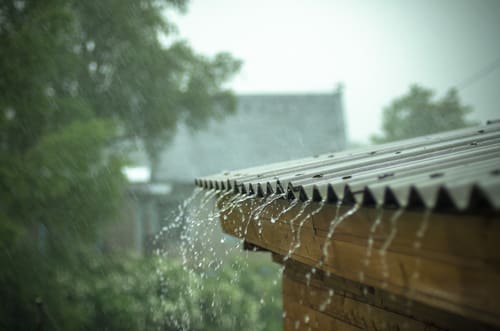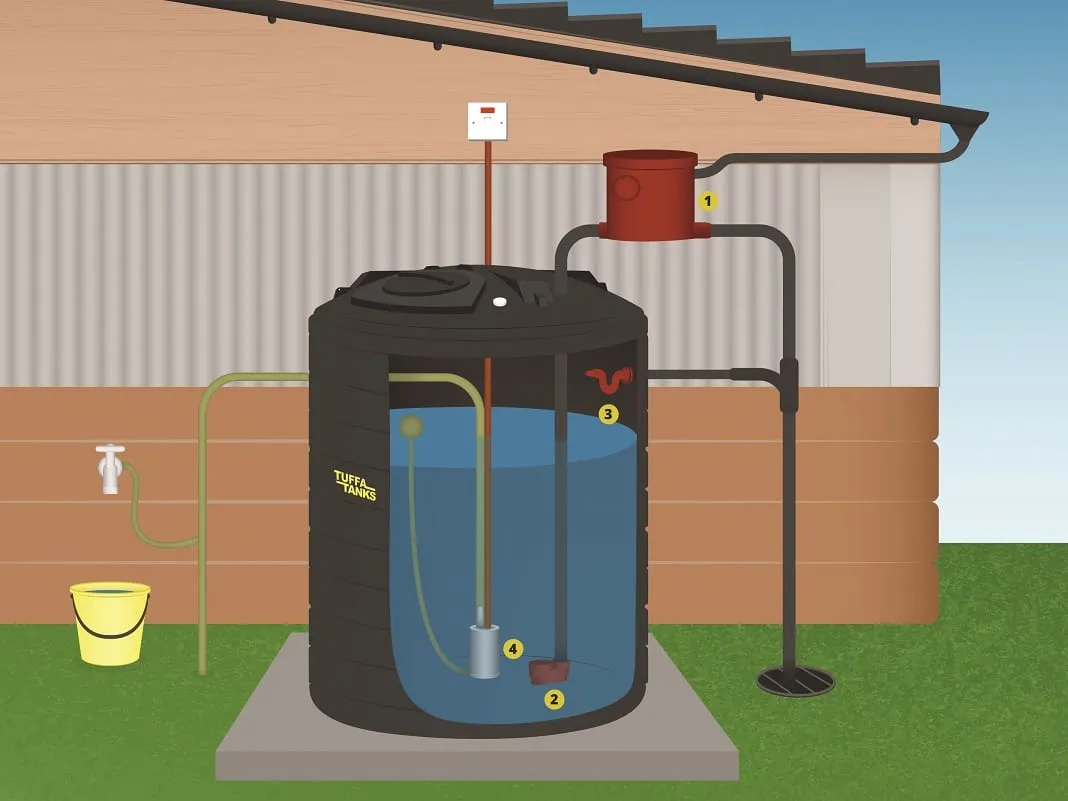Rainwater harvesting tanks offer homeowners, businesses and farmers numerous benefits. Not only does collecting rainwater reduce metered water bills, but it also has various ecological advantages and offers the tank owner self-sufficiency. Additionally, the properties of rainwater often make it better quality than treated water for many applications. This guide acts as an ‘everything you need to know’ about rainwater harvesting including how to harvest rainwater, how much rainwater you will harvest, and installation guidance.
What makes us experts? Tuffa Tanks have been manufacturing tanks for over thirty years. During that time we have supplied plastic water tanks to all kinds of industries for many different uses, from fire fighting water tanks to rainwater harvesting tanks to irrigate smallholdings. We’ve gathered our knowledge to help you to understand everything rainwater harvesting.
What is rainwater harvesting?
Rainwater harvesting is the process of collecting rainwater which falls onto a large surface area (usually a rooftop). Rainwater harvesting kits connect to guttering and downpipes and filter rainwater before it’s stored in the tank – rather than letting it go to waste in drainage.
What are rainwater harvesting tanks?
Rainwater harvesting tanks are effectively high-quality water butts capable of storing large quantities of rainwater for domestic, agricultural and commercial applications. The plastic water tanks we manufacture are capable of storing between 1,350 to 20,000 litres as a single unit and can be interlinked to achieve higher capacities.
buyer
guides
Find out everything you need to know about tanks with our expert guides.
total
satisfaction
96% of our customers would recommend us
What are the differences between Potable and Non-Potable Water Tanks?
When browsing for water tanks, you may notice that they are labelled as either potable or non-potable, but what does this mean?
The simple answer is that a potable water tank is suitable for storing drinking water, whereas a non-potable water storage tank is not.
All potable water tanks must adhere to WRAS (Water Regulations Advisory Scheme) regulations, in order to keep the water safe for consumption when it comes into contact with the materials of the tank.
Why Potable Water Storage Tanks are Important
Potable tanks are a necessity in order to store safe drinking water, especially when tap water is not an option. By and large, tap water is readily available in residential and commercial buildings, however, a system failure can soon leave anywhere without clean water.
Shelters may not be connected to a safe drinking water system, with numerous people reliant on a water storage tank for access to water for them and their families. Without access to clean water, the health of those affected is put at serious risk.
Usage of Non-Potable Tanks
Just as potable tanks are important for use on a day to day basis, so too are non-potable tanks, as the water stored can be used for plumbing, such as flushing the toilet and in washing machines, as well as for gardening.
Tap water, or potable water, is filtered to make it safe for consumption, whereas non-potable water is usually harvested rainwater that has not been filtered or manipulated. While rainwater is not suitable for human consumption, it is highly beneficial to the growth of plants and produce, which is why it is not uncommon to find agricultural settings making use of rainwater harvesting tanks.
What are rainwater harvesting tanks used for?
Domestic
Domestic applications of our plastic water tanks include horticultural use and ‘greywater’ applications such as laundry, washing dishes and flushing the toilet. Water for these domestic applications account for around half of your total domestic water usage – this can be supplied by rainwater.
Commercial
Rainwater can be used for most commercial applications where the water will not be consumed. Leisure facilities such as golf courses use large quantities of water for nurturing the lawn or simply to flush toilets. We sell rainwater harvesting tanks to the transport industry for washing buses and trucks. Rainwater often makes it a perfect additive to chemicals for specialist uses where water purity is a necessity. Rainwater harvesting is also popular with businesses with an ecological focus such as the Globe Foundation’s Eco Centre in Staffordshire.
Agricultural
Water usage within the agricultural industry is higher than any other industry. With hundreds of acres of crops to irrigate, pens to clean and thousands of livestock needing water it’s no wonder that water demand is high. Instead of solely relying on mains water, many farms use alternative sources of water. According to a report from the Department for Environment Food & Rural Affairs, 25% of farm businesses use bore holes, 8% rainwater storage and 6% stored water from rivers, streams and springs.
How do I harvest rainwater?
Harvesting rainwater involves three simple steps: collection, transport and storage. To increase the quantity and quality of water there are a few considerations at each stage.
Find a collection area
Rooftops usually offer the best catchment area due to their elevated position and large surface area. Because rooftops catch rainwater before it reaches the ground it also prevents water contamination.
Transport and filter the water to the tank
Another benefit of using a rooftop to collect rainwater is the ability to transport rainwater to the plastic water tank via guttering and downpipes. Most large buildings will have pre-existing guttering which can be fitted with a rainwater filter kit. Our filter kits purify the water and remove contaminants before the water is stored.
Wire mesh can be used as an alternative form of filtering rainwater from large debris such as leaves. A wire mesh frame covers the entire length of the guttering, or a wire ‘balloon’ can be used to cover the downpipe before entering the tank. This is usually only suitable for basic applications such as gardening.
Find a storage area
The third step is to store the water in a container with a large enough capacity for the roof size and application. For horticultural uses in a small to medium garden, a water butt is often adequate. These are available for around £50 for a 300 litre capacity tank. For domestic applications requiring a higher capacity tank then a small 1,350 or 1,400 litre capacity tank can be used. These are available from around £350 and benefit from greater quality, durability and lifespan.
Commercial, industrial and agricultural buildings usually have a large roof size and their applications require larger capacity tanks. Individual plastic water tanks reach a capacity of around 20,000 litres with a basic tank costing around £2,000.

What are the benefits of rainwater harvesting?
Financial
Water usage accounts for one of the largest household bills costing around £430 annually with the average family home using nearly 350 litres of water per day according to Energy Saving Trust. It’s estimated that greywater usage (for toilets, washing clothes, watering gardens and cleaning cars) makes up around half of the total water usage for domestic properties. Water for these applications don’t need treating and can be supplied by rainwater harvesting. By making the most of this free resource you can expect to save around 50% on your metered water bills. For commercial, industrial and agricultural applications the savings can dramatically increase.
Quality
Not only is rainwater free but the water quality and properies are often more beneficial for the intended application than mains water. The salts, minerals and chemicals used to make water safe for human consumption can be detrimental for other uses.
Plants have been growing for nearly 500 million years and have evolved to thrive off rainwater. It’s hardly surprising that rainwater, which is mildly acidic and contains organic compounds which act as a fertiliser, is perfect for horticulture. Comparatively, the water that comes from your taps has a neutral pH balance and contains chemicals that build up over time and make it tough for plants to thrive.
Rainwater is also naturally soft and offers ideal conditions for washing and cleaning. This reduces the need for detergents, soaps and water softener thus minimising operational costs. Maintenance costs can also decrease as water heaters and pipes don’t suffer from deposits caused by hard water.
Certain industries require pure water free from additives for sensitive work such as microchip manufacturing and photographic processing. Rainwater is naturally filtered and a cheap alternative to spring water which can be very costly in large quantities.
Environmental and managing climate change
While droughts in the UK are currently fairly rare, Climate Reality Project predicts extreme weather to become more common in the UK as the effects of climate change amplify. Conversely, this is predicted to lead to both drought and flooding. In such conditions, rainwater harvesting will become more mainstream as it helps to manage the consequences of both: reducing local erosion and flooding by storing water during heavy rain, and then lessening the strain on reservoirs and public water sources in drought.
By harvesting rainwater you are also reducing your carbon footprint. Rainwater is carbon neutral whereas the process used to treat and transport mains water means that it has a carbon footprint of 0.3 grams per litre of water. Unlike water from our reservoirs, rainwater is also completely sustainable.
How do I build a rainwater harvesting system?
A rainwater harvesting system consists of a water tank and a harvesting kit designed to collect, filter and pump rainwater. The kits we supply are suitable for most domestic, commercial, and agricultural applications with roof sizes up to 800m².
Step 1
Rainwater filter diverter
Rainwater falls from the rooftop into the guttering and through the filter which removes debris before it’s stored in the tank.
Step 2
Calmed inlet
The diverted water runs down a pipe to the bottom of the tank where it’s released through the calmed inlet. This process oxygenates the existing water which prevents it from stagnating.
Step 3
Overflow siphon
When the tank reaches maximum capacity the overflow siphon diverts the excess water to drainage. This process also removes pollen from the water surface to keep it clean.
Step 4
Submersible pump
Where required a submersible pump directs the water from the bottom of the tank to the desired output such as a hose or washing machine.

How much rainwater can I harvest?
Accurately calculating the amount of rainwater you can harvest is extremely difficult and depends upon various factors such as roof size, pitch and material. However, for a basic calculation, you can use the following formulae: 1 inch of rain x 1 square meter = 25 litres
The average monthly rainfall in the UK is 3.5″ (89mm). However, rainfall varies depending on the time of year and your location. Find accurate rainfall statistics for your location on the Met Office website.
What size rainwater harvesting tank do I need?
The water tank size you need depends upon the application, your water usage, roof size, and location. Water tanks that solely rely on rainwater should have a large enough capacity to cope with periods of low rain or even drought. However, with mains water back up there is no risk of becoming completely depleted of water meaning you can purchase a smaller tank – albeit at a greater risk using the mains water. Through experience, the tanks we sell often have a capacity depending upon the industry and application.
What water filter and pump do I need?
Rainwater Filter Collector- roof sizes up to 90m²
The universal rainwater filter is suitable for roof sizes up to 90m² and fit water butts and tanks. This filter reduces the level of dirty water, sludge, algae, leaves and other debris that enters the tank by diverting it through the down-pipe ensuring that only filtered water reaches the tank. Once the tank is at full capacity the filter will also act as the overflow outlet.
The kit includes 30cm of reinforced hose, rubber washer, back nut, cutting tool and a universal link kit enabling the filter to connect to any tank or water butt.
Rainwater Diverter Tank Kit – roof sizes up to 200m²
Water filters from this size are suitable for water tanks only. In this system, the rainwater flows through a filter cartridge which cleans the rainwater and diverts it through the downpipe to the calmed flow inlet leading to the tank. The dirty water is redirected to the sewer.
This system is low maintenance with a self-cleaning design and comes with a calmed inlet and overflow siphon.
Rainwater Diverter Tank Kit – roof sizes up to 450m²
This filter has two inlets which directs rainwater into the main chamber where it goes through a dual cleaning process. In the pre-cleaning process the water falls down a cascade where the larger contaminants are directed to the sewer. Then the water flows through a secondary filter sieve before it’s directed to the calmed inlet.
Depending on use, this low maintenance filter should be cleaned once or twice a year. It comes with a calmed inlet and overflow siphon.
Rainwater Diverter Tank Kit – roof sizes up to 800m²
This filter is for large roof areas up to 800m² and has 2 inlets, 2 tank inlets and 2 sewer outlets – these can be plugged if only one inlet or outlet is required. This filter has a two step filtering process. In the pre-cleaning process the water falls down a cascade where the larger contaminants are directed to the sewer. Then the water flows through a secondary filter sieve before it’s directed to the calmed inlet.
This filter pack includes a calmed inlet and overflow siphon.
Water pump
Submersible water pumps are often required to transport water to hoses or appliances such as washing machines where a strong flow is needed. We supply standard submersible water pumps and water pumps with mains water backup. Mains water backup diverts tap water to the rainwater tank when it’s low and is required for applications which need a guaranteed water supply.
Where should I site a rainwater harvesting tank?
Siting your water tank properly will save you time and money. Ideally, you should site the water tank near to the downpipes of a rooftop with existing guttering. This will make installation much easier and reduce the pipework required. For tanks using water pumps an electrical output will be required so site the tank near to an electric supply where possible.
To keep rainwater fresh you should choose a naturally shaded spot to cover the tank from direct sunlight. The heat of the sun will warm the tank water and produce an environment where microorganisms such as algae can grow more rapidly. Additionally, water tanks which aren’t UV stabilised can warp in direct sunlight. All of our water tanks are UV stabilised and our vertical 1350 litre rainwater harvesting tank often offers the best solution to ensuring your tank stays shaded as it can fit in confined areas at the side of buildings, walls and fences.
What base do I need for my plastic water tank?
To protect the water tank’s integrity it needs to be installed on a base capable of supporting the weight of the tank at full capacity. 1,000 litres of water weighs 1 tonne. With water tanks capable of storing 20,000 litres (20 tonnes) the base is a vital consideration to protect the tank and prevent a leak from occurring.
We recommend siting the water tank on a flat, solid and level base to ensure there are no pressure points on the tank. Before siting the water tank on the base it must first be swept clean as stones can penetrate the floor of the tank over time. Common materials that can be used for the tank base include:
- Concrete
- Pea gravel (ensuring no large stones)
- Sand
Where a granular material is used a border should be provided to prevent the material from washing away.
If the tank is sited in a location where it can be knocked over (particularly when empty) by machinery or natural forces then you should consider installing an anchor or fixing the tank to the base.
How do I clean and maintain a water storage tank?
Inevitably debris will enter a water storage tank even when rainwater is filtered. This can leave a film of sludge at the bottom of the tank. Cleaning and maintaining your tank annually will keep these contaminants to a minimum which will also prolong the life of your filters, pump and tank.
You can hire professional services to clean your water collection tank for you. Professionals have the equipment to clean a water tank with a minimum level of water being wasted. Where not using professional equipment you will have to drain the tank first. For this reason, the end of summer often offers the best time of year to clean your tank – when it’s naturally running low due to drought.
Once the tank is drained use a hosepipe (preferably with a pressure wash) and flush out the remaining water aiming for the bottom of the tank and any corners or depressions in the tank. As well as cleaning the tank it’s also important to remove any debris from your filters and clean the pump.
We hope that you found this guide useful but if you still require further advice or a quotation please submit an enquiry or give us a call on 01889567700.













